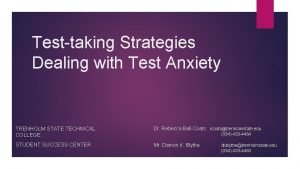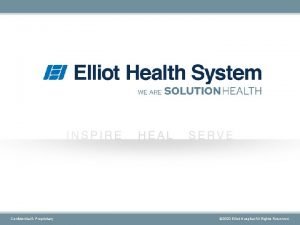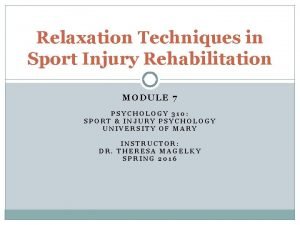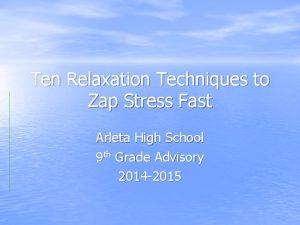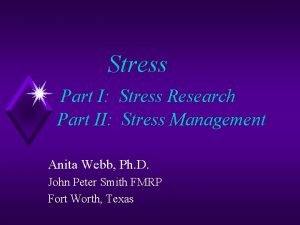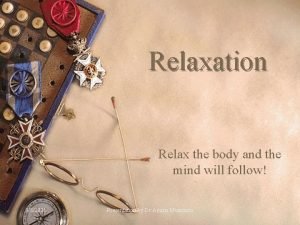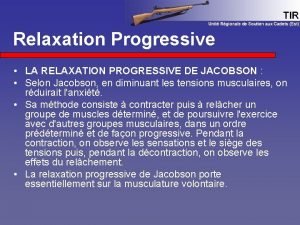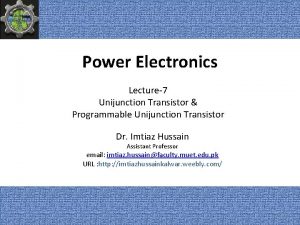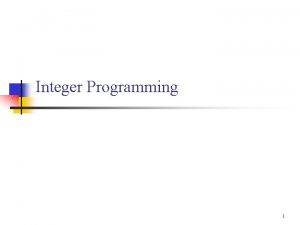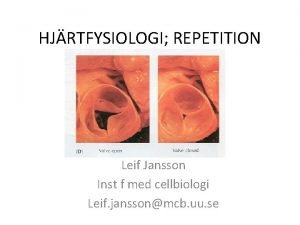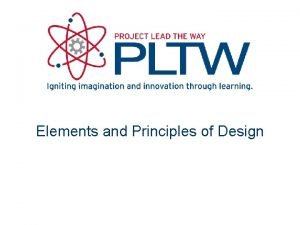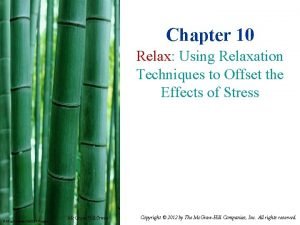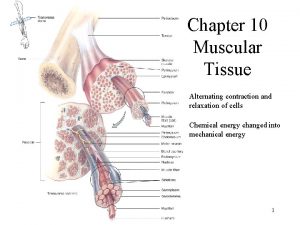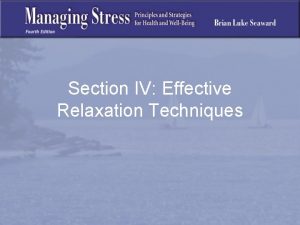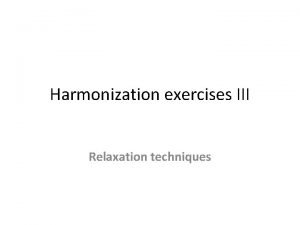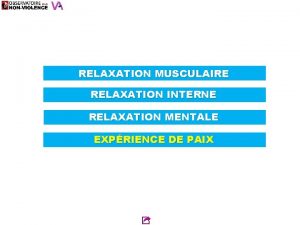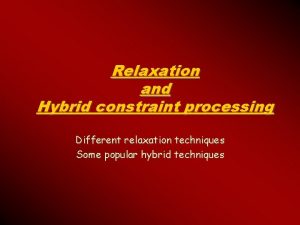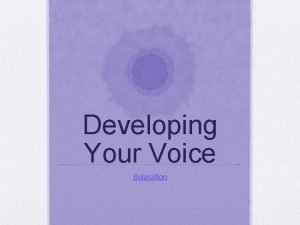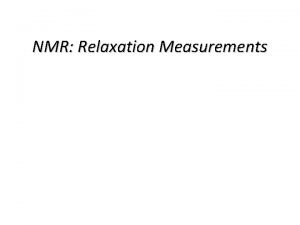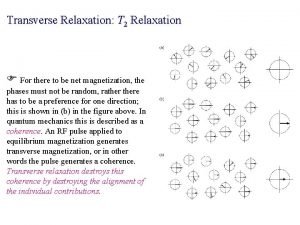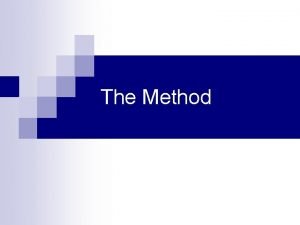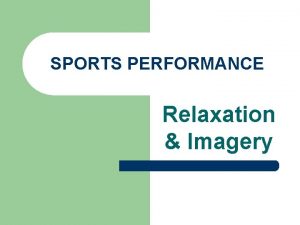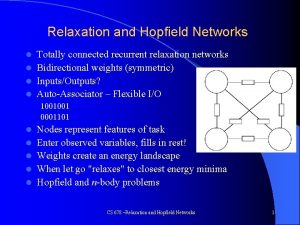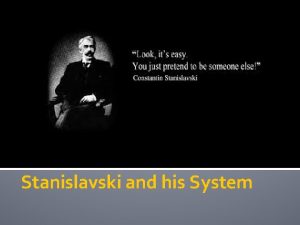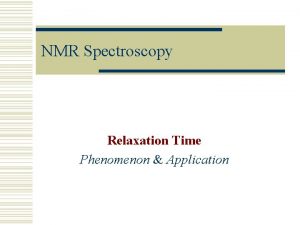Section IV Effective Relaxation Techniques Effective Relaxation Techniques
















- Slides: 16

Section IV: Effective Relaxation Techniques

Effective Relaxation Techniques Purpose of Relaxation Techniques: • To return to homeostasis • To reverse the effects of the stress response • To engage the parasympathetic NS • To alleviate the symptoms of stress

Effective Relaxation Techniques Every relaxation technique engages one or more of the five senses: • • • Sight (e. g. , visualization) Sound (e. g. , music therapy) Taste (e. g. , comfort foods) Smell (e. g. , aromatherapy) Touch (e. g. , muscle massage)

Effective Relaxation Techniques • There are hundreds of ways to relax • Sleep is not the same thing as relaxation – (high blood pressure and muscle tension can occur during dreams)

Mind-Body Connection Although the relaxation techniques are geared to reduce the symptoms of stress (e. g. blood pressure, heart rate, muscle tension) the mind and body cannot be separated and the mind benefits as well.

Diaphragmatic Breathing Chapter 17

“Let the air breathe for you. ” -Emmett Miller, M. D.

Diaphragmatic Breathing • Is one of the easiest and most effective methods of relaxation • It is controlled, deep breathing • In the practice of yoga, this technique is called the pranayama

Thoracic Breathing and The Stress Response • By and large, Americans are thoracic breathers • We breathe with the emphasis on our upper chest • The consequences include slight pressure on the sternum and pressure on the solar plexus nerve. • This tends to trigger a slight stress response causing: – A rise in heart rate, blood pressure, and other parameters • Thoracic breathing does not promote relaxation • Everyone employs belly breathing when they sleep!

The Mystery of the Breath • Breath is considered by many to be the universal life force of energy – (e. g. , Chi, Pranayama, etc. ) • Breath is synonymous with the word spirit in many cultures • We infer spirit with the word breath with the words: – Inspiration – Expiration

Steps to Initiate Diaphragmatic Breathing Assume a comfortable position Concentration Visualization

Four Phases of Concentrated Diaphragmatic Breathing • Phase I: inspiration (Long) • Phase II: a very slight pause before exhaling (Short) • Phase III: exhalation (Long) • Phase IV: another slight pause after exhalation before the next inhalation is initiated (Short)

Other Techniques and Diaphragmatic Breathing • The majority of effective relaxation techniques integrate belly breathing -Hatha Yoga -T’ai Chi -PMR -Autogentic Training -Others -Massage Therapy -Music Therapy -Biofeedback -Visualization

Diaphragmatic Breathing & Chronic Pain • Breathing is often used to help people with chronic pain, both as a means to lessen the pain and serve as a pleasant distraction from pain. • It’s no secret that breathing is used for acute pain, as with Lamaze breathing during childbirth.

Visualization and Diaphragmatic Breathing • Visualization exercise I: breathing clouds • Visualization exercise II: alternate nostril breathing • Visualization exercise III: energy breathing

Best Application of Diaphragmatic Breathing • This technique can be done anywhere (e. g. , driving, exams, falling asleep, etc. ) • This technique can be done relatively shortly for an effect (5 -10 minutes) • Never underestimate the power of a good sigh!
 Relaxation techniques test anxiety
Relaxation techniques test anxiety Muscle relaxation techniques
Muscle relaxation techniques Relaxation techniques in sport
Relaxation techniques in sport 10 relaxation techniques that zap stress fast
10 relaxation techniques that zap stress fast Cephalic stage of digestion
Cephalic stage of digestion Psychosocial factors examples
Psychosocial factors examples Successive over relaxation method
Successive over relaxation method Relaxation response technique
Relaxation response technique Relaxation progressive de jacobson
Relaxation progressive de jacobson 2n2646 equivalent transistor
2n2646 equivalent transistor Pc steel wire
Pc steel wire Lp relaxation 이란
Lp relaxation 이란 Starling's law of the heart
Starling's law of the heart Visual design principles and elements matrix
Visual design principles and elements matrix Gauss seidel method example
Gauss seidel method example Relaxation response technique
Relaxation response technique Alternating contraction and relaxation
Alternating contraction and relaxation
